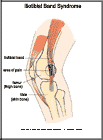
Iliotibial Band Syndrome
What is iliotibial band syndrome?
Iliotibial band syndrome is inflammation and pain on the outer side of the knee. The iliotibial band is a layer of connective tissue. It begins at a muscle near the outer side of your hip, travels down the outer side of your thigh, crosses the outer side of the knee, and attaches to the outer side of your upper shin bone (tibia).
How does it occur?
Iliotibial band syndrome occurs when this band repeatedly rubs over the bump of the thigh bone (femur) near the knee, causing the band to be irritated. This most often occurs in running.
This condition can result from:
- having a tight iliotibial band
- having tight muscles in your hip, pelvis, or leg
- your legs not being the same length
- running on sloped surfaces
- running in shoes with a lot of wear on the outside of the heel.
What are the symptoms?
The symptom is pain on the outer side of the knee.
How is it diagnosed?
Your health care provider will examine your knee and find tenderness where the band passes over the bump on the outer side of your knee. Your iliotibial band may be tight.
How is it treated?
Treatment includes the following:
- Place an ice pack over your iliotibial band for 20 to 30 minutes every 3 or 4 hours for 2 to 3 days or until the pain goes away.
- You can also do ice massage. Massage your knee with ice by freezing water in a Styrofoam cup. Peel the top of the cup away to expose the ice and hold onto the bottom of the cup while you rub ice over your knee for 5 to 10 minutes.
- Take an anti-inflammatory medication, according to your health care provider's prescription.
- Do the stretching exercises recommended by your health care provider or physical therapist.
Your provider may give you an injection of a corticosteroid medication to reduce the inflammation and pain.
While your knee is healing, you will need to change your sport or activity to one that does not make your condition worse. For example, you may need to bicycle instead of run.
When can I return to my sport or activity?
The goal of rehabilitation is to return you to your sport or activity as soon as is safely possible. If you return too soon you may worsen your injury, which could lead to permanent damage. Everyone recovers from injury at a different rate. Return to your sport or activity will be determined by how soon your knee recovers, not by how many days or weeks it has been since your injury occurred. In general, the longer you have symptoms before you start treatment, the longer it will take to get better.
You may safely return to your sport or activity when, starting from the top of the list and progressing to the end, each of the following is true:
- Your injured knee can be fully straightened and bent without pain.
- Your knee and leg have regained normal strength compared to the uninjured knee and leg.
- You are able to jog straight ahead without limping.
- You are able to sprint straight ahead without limping.
- You are able to do 45-degree cuts.
- You are able to do 90-degree cuts.
- You are able to do 20-yard figure-of-eight runs.
- You are able to do 10-yard figure-of-eight runs.
- You are able to jump on both legs without pain and jump on the injured leg without pain.
How can I prevent iliotibial band syndrome?
Iliotibial band syndrome is best prevented by warming up properly and doing stretching exercises before sports or other physical activity.

